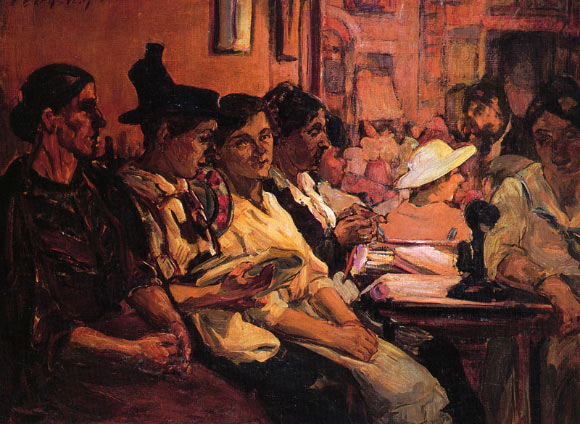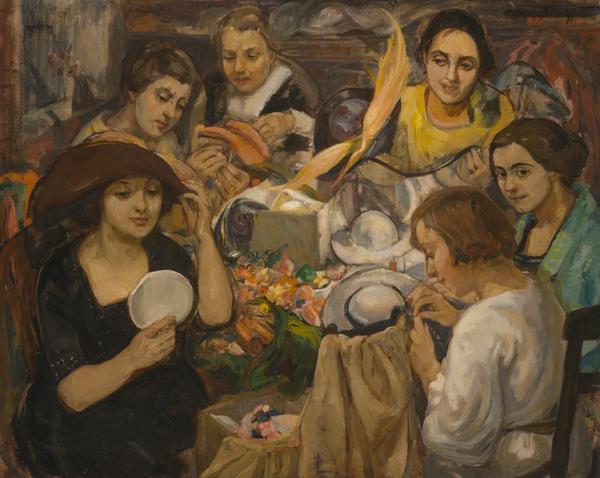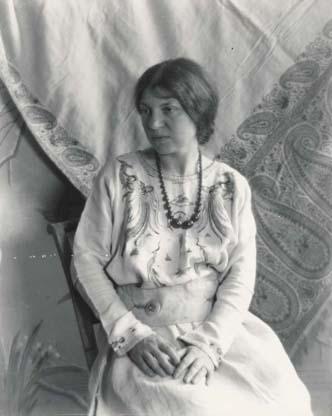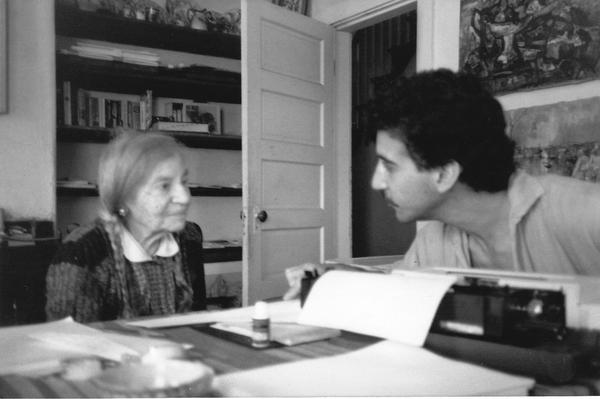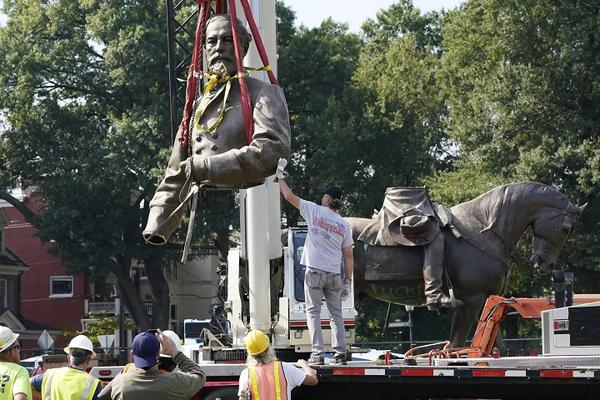March 14, 2025 Hello , Critics both hailed and flailed Theresa Bernstein for ''painting like a man'' in the 1910's, according to the New York Times. But she outlasted every male artist, continuing to create her entire life, her last exhibition featured 110 of her art works in celebration of her 110th birthday. Theresa Bernstein, born in 1890, died in 2002—two weeks before her 112th birthday—captured the pulse of the entire 20th-century America with oil on canvas. Her New York
Times obit told of her legendary determination. "When she broke her right hand, she painted with her left. When she could no longer hold a brush, she painted by squirting paint from tubes." Not well-known during her decades of work, her paintings hang in
private and museum collections and now sell for $100,000. But it was the work itself that mattered to Theresa Bernstein. Thanks to Beverly W. for suggesting the story of this incredible woman!
Early reviewers praised her modernist style painting with words like blazing color, gritty, enthusiastic, brilliant gestural brushwork and "masculine."
Untitled oil painting, Theresa F. Bernstein, 1982
''It is with a man's vision that this artist looks at her subjects -- in the streets, the elevated trains, at the beaches, in the parks, the lobbies of theaters, in seaport places or in a church,'' a reviewer wrote of her first first solo show in 1919. ''Then having found what she wants, it is with a man's vigor that she gets it down to stay.'' In rebuttal, eighty years later, Patricia M. Burnham wrote in the American Art Review, Ms. Bernstein "showed a decidedly feminine sensibility," incorporating into her paintings female
activities ignored by male artists. "...women readers using the New York Public Library, traveling unchaperoned on the El, making hats, creating art in the company of other women, applying for jobs.''
Waiting Room – Employment Office by Theresa Bernstein, 1917, oil on canvas. Image credit: The Jewish Museum, New York. Others insist Theresa's work, speaks for itself. ''She was just a great painter, period,''
said Jan Ramirez, Director of the New-York Historical Society's museum. Initially, Theresa signed her work with only her last name, leaving her gender
unidentified, yet defining her own lane.
"Since there was always the inevitable comparison with the art of men, juries and scholars wouldn’t accept a woman on the same basis," she said. "One has to understand that there are limitations not in one’s expression but in one’s
status.”
The Milliners, Theresa Bernstein, described by Annelise K. Madson as "a lively jumble of dexterous hands
and still-life accessories and an orchestrated vision of concentration and community." In a life and artistic career spanning the entire twentieth century, Theresa Bernstein painted WWI soldiers, hippies in Central Park, boom boxes and break
dancers on New York City sidewalks. She painted harbors and beaches, swimmers and still lifes. Teaching and exhibiting, she was for a time more popular than realist painter Edward Hopper, a familiar figure in the New York art world and the summer colony at Gloucester, Massachusetts. As taste
turned abstract mid-century, Theresa Bernstein's figurative work lost appeal, but continued to portray real life and people, breaking the barrier between high art and the everyday. She painted one of her most well-known scenes in 1927, immigrants arriving on a boat in the harbor, it's more difficult to find her later work
online.
The Immigrants, oil on canvas, Theresa Bernstein, 1927. The artist tended to claim she was born and raised in Phiadelphia, which is all she would have remembered, but in fact, Theresa was born Cracow, Austro-Hungarian Empire (now Kraków, Poland) in 1890 and her parents brought her to America as a one-year-old, She started to draw and paint as a child, going on to win a scholarship to study at Philadelphia School of Design for Women in 1907 at age 17. After graduation, she settled in Manhattan in 1912 and landed her first solo exhibit in 1919. New York painter and etcher William Meyerowitz, one of those with the opinion her work was "masculine," came calling to ask for a donation to a charity that gave artworks to the poor. ''Oh," he said in surprise, "I thought you were an older man.'' Either she wasn't offended, or readily forgive him, as the two fell in love and married.
Theresa Ferber Bernstein, 1930. The Juley Collection at the Smithsonian American Art Museum Her bright colors gave way to somber tones briefly after she and Meyerpwitz only child, Isadora G.R. Meyerowitz died of pneumonia in 1920 as an infant. She and her husband were close, often painting side by side. His work gained more recognition than here hers, Theresa apparently unbothered. “I never got frustrated," she confided in her journal, "because I didn’t expect anything. I enjoyed painting the works I did. I didn’t do it for public acclaim.” Their happy marriage lasted for 63 years, until he died in 1981 .Even then she continued to promote his work, though some years later she when she hoped to set up an exhibition of his work at the Museum of the City of New York
curators decided to shows instead.
On the Docks, Gloucester, ca. 1916 | THERESA BERNSTEINTheresa Ferber Bernstein,
1930. The Juley Collection at the Smithsonian American Art Museum The usual question arises as to how such a prolific and once well-known woman fades to obscurity. Was it bias against women or becoming victim of her own self-effacement? Three years after her husband's death, she revealed hundreds of her own paintings. While during his life, he didn't allow
her work to be on display in his studio. She didn't reap the fame of Georgia O'Keefe, who was married to Art Promoter Alfred
Stieglitz, also a photographer who exhibited his photographs of the artist in the nude. Bernstein is now gaining more recognition for her lifetime of steady,
consistent work in a signature style—her paintings and prints held in uncounted private collections as well museums, including the Metropolitan Museum of Art, the Smithsonian Institution, and the New York Public Library. We can get a personal sense of this amazing woman who lived through an entire century from her grand-nephew, who spent summers with her in Gloucester in the salt box cottage she and her husband bought in the 1920s. To Keith Carlson, she was family, mentor, revered elder and friend.
Theresa Bernstein and grand-nephew Keith Carlson, 1987. Photo courtesy of Keith
Carlson. "Spending time with Theresa was like being in the company of a living master who was at once an imposing presence and a delightful and mischievous sprite who loved to laugh, tell stories, consume impressive amounts of ice cream, and paint and
write prodigiously." Painter, printmaker, teacher, poet, and art activist, at age 91 embarked on a new career as a writer, publishing several books. She never lost her artists eye. Several years before she died, a friend pushed Theresa's wheelchair past a Valentine's window display. Spying the couple kissing, the artist called out—''Get my sketch pad!''
Like my article today? Forward this email to share with family and friends.
Robin Lindley, a writer with the History News Network Ty Seidule talks what it meant to him to see his one-time hero Robert E. Lee fall from
grace.
Crews remove a statue of Confederate General Robert E. Lee on Monument Avenue, September 8, 2021 in Richmond, Virginia. A soldier at West Point, later on the history faculty at the army academy and now historian of the school, Ty Seidule explains who his views of General Lee started to change when he realized West Point was an anti-Confederate monument for more than 50-years after the Civil
War. The first Robert E Lee memorial was erected in the 1930s and the last in 2002. "I understood the Civil War was about slavery, but for too long, I held romantic notions of Lee. Then, when I started studying West Point’s memorialization of Lee, I just became outraged that tributes
to Lee came at the same time as integration. That made me not just a historian but an activist for change." And if you want to be an activist for change here are a
couple quick things you can do: - Exercise your legal right to defend your privacy and establish the security of your private information. The U.S. District Court for the District of Columbia has issued an injunction commanding DOGE to comply with citizen requests under the Freedom of Information Act. Find out what's happened to your data. File your written request by printing this letter and mailing it.
- Send a postcard to the White House for the Ides of March. That's tomorrow.
On March 15th tell the
president what you think of the job he's doing. Mail to: Donald J. Trump The White House 1600 Pennsylvania Ave NW Washington, DC 20500 Take care.
Follow me on social media
This newsletter is a reader-supported publication. To support my work, consider becoming a paid subscriber.
Read
a great book? Have a burning question? Let me know. If you know someone who might enjoy my newsletter or books, please forward this e-mail. I will never spam you or sell your email address, you can unsubscribe anytime at the link below. To find out more about my books, how I help students, teachers, librarians and writers visit my website at www.MaryCronkFarrell.com. Contact me at MaryCronkFarrell@gmail.com. Click here to subscribe to this newsletter. |
|
|


